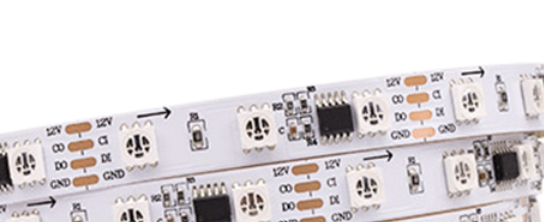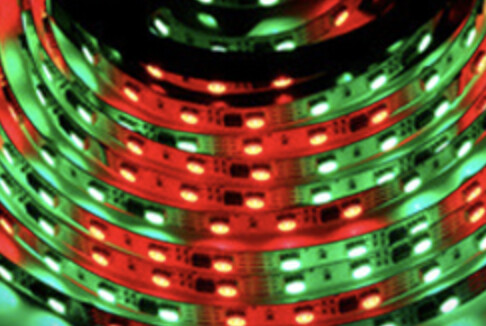Regarding the relationship between current draw and brightness: there is (almost) none! The GS8208 uses a unique design where the three RGB LEDs are connected in series, and the chip provides a current shunt across each one. Each pixel will draw the same current (about 20mA) no matter what color or brightness level it is (except of course, completely off). So reducing the brightness will not reduce the current draw of your system.
crap… good to know though. Any idea of the ws2815’s suffer the same flaw?
I believe the WS2815 works the same way. But is is not a flaw! It allows each pixel to use only 1/3 the current at full brightness as compared to other designs that put the LEDs in parallel.
So overall more efficient, but brightness doesn’t control consumption. got it.
Alright. good to know. Thank you for finding that for me.
Brightness (single color max) does control consumption, in both GS8208 and WS2815. The WS2815s also use this 12V design where any one color at high current causes the other colors to be shunted by the MOSFETs and thus uses 3 * max(r, g,b).
The only efficient 12V systems are the ones that have regulators built-in to the strips. Here’s a premium product like this, and here’s one that has a noticible but acceptable failure rate according to online experiences shared.
While I don’t know about the GS8208 RF rejection, I do know their built-in gamma curve is really nice, and noticeably better than any WS28XX:
@Irwin, totally. I appreciate it. And in practice, a lot of patterns will draw close to max.
One thing I measured to my surprise though - Quindor measured 17mA max through of some, which is on-par with current in 5V strips; the ones I ordered though, I can’t get more than 12.2 mA going through any pixel; this is much like my WS2815s where I get 11.5 mA per pixel max.
That video is excellent in showing the difference. looks like the 2815’s are 3030’s and the 2808’s are 5050. didn’t even realize by the product descriptions i was reading. Brightness stepping is going to be important in my application. so gs2808’s it is. I think i will order the same ones from your other post from ali-express (provided it doesn’t take 6 months to arrive) as they are WAY cheaper, and if they don’t have the test pattern, all the better. 
This is lower than I had originally assumed. great information.
Thanks everyone for the input and responding so quickly. So much as been clarified in my brain so quickly.
If I run into any more issues I will definitely post.
another user had found these
12v apa102’s… any thoughts on this. As i looked at the shipping time frame from aliexpress and it’s over a month. these be any better than the gs2808’s? They are nearly the same price. about 15 bucks more for the same quantity.
wait, scratch that. these apa’s are only 1m each for the same price. gs2808’s it is. 
Hi Gabe,
A few notes/clarifications, I think mostly covered elsewhere, just wanted to mention it here just in case.
- GS2808/GS2806 with built in patterns can look glitchy sometimes when there is a pause in data. Pixelblaze may pause data when switching patterns or saving data to flash, or if there is a code error in a pattern.
- I’ve had some reports that gs2808 can fall back to a 400khz data mode, mostly reported with V2 Pixelblazes. I think they look for certain timing clues, switching automatically, and are thus not as forgiving as WS28xx type LEDs and other clones. In general the output expanders and V3 have more conformant data signals than V2 does (though V2 has more flexibility in data rates).
- Both GS2808 and WS2815 12V LEDs work by running the RGB elements in series so that they use the same current/power regardless if they are turning on a single element, 2 elements, or all 3. They will still use less power with lower brightness levels.
I’ve measured WS2815 @12V using 12.04mA to 12.58mA when drawing at full brightness. The lower current figure is actually white, and the higher value is a solid color, I’m not quite sure why. I’ve seen them draw 1.85mA when idle / black.
I don’t have figures for the GS2808 but I suspect it is similar.
@jeff Quindor’s measurements are at the AC input to his power supply (or at least originally were), so you have to figure power supply conversion losses (the efficiency of which varies by load). That data is good for relative comparison, but not going to translate to what you would measure on a multimeter or what you would use to calculate your output load requirements.
@Gabe Keep an eye out for some tricks used in other 12V addressable LEDs, like that 12V APA102 strip you linked, that will most likely run 3 LEDs in series (not elements), meaning each “pixel” is actually drawn on 3 different LEDs. Good for zone lighting, but not fine-detail pixels.
Yet another thing to look out for is inefficient 12V addressable LEDs that wire single elements to parallel lines, for example WS2811 can be used with 12V to efficiently drive 3 LEDs per pixel, or a single LED inefficiently – both configurations draw the same current/power, but with the single LED setup the extra power is lost as heat.
@wizard" Keep an eye out for some tricks used in other 12V addressable LEDs, like that 12V APA102 strip you linked, that will most likely run 3 LEDs in series (not elements), meaning each “pixel” is actually drawn on 3 different LEDs. Good for zone"
When you look look at the strip how do you tell the difference?
Twilight

Clues:
- The cuttable section is every 3 LEDs. With individually addressable LEDs that have internal drive circuitry, it costs them nothing to have cuttable solder pads between each pixel so they usually do, even for high density 144/M strips.
- There’s an IC in addition to the LEDs, this means each LED won’t have it’s own driver, so the one IC must be able to drive 3 RGB LEDs.
- The IC has 10 pins only, it would need 9 pins alone just for 3 RGB LEDs driven in parallel, or 6 pins if muxed using some shared pins. It also needs 2 for power, and 4 more for data + clock inputs and outputs. There’s just not enough pins.
- In the description:
Q’ty of LED: 60 leds/Meter Available
Q’ty of IC: 20 pixel /Meter
The wording is strange, but the gist here is you get 20 pixels per meter even though there are 60 LEDs per meter.
5. For 12V there’s only so many ways you can efficiently drive LEDs which only need about 2.4-3.4V each.
6. None of the photos demonstrate individual pixel colors beyond every 3 LEDs, though I’ve seen fake photos so I wouldn’t take it alone.

@wizard two questions about this.
- Ignoring the chip, would there be any downsides you can think of to having 3 APA102s in series, if I really wanted zones of 3 and wanted to run 12V? I imagine you have to pick just one of the APA102s to pass on data and clock from, right?
- What in the world do you think that “APA 102 external IC” is? I can’t find reference to external APA102 chips anywhere else.
It wouldn’t work to have 3 of the individually addressable 5V APA102’s in series. Their impedance varies by load so the voltage seen across any individual package could be too high or too low, and current would only flow if they were all “on” at the same time (not just data synchronized, but their PWM intervals + phase as well).
I don’t see anything wrong with 3 LEDs per pixel, thats totally fine for many illumination applications. Its like a 20/M strip density, but 3x the brightness.
My guess is that it’s some kind of clone, can’t find anything like that in a quick search.
So for the strip to actually be individually addressable it has to have one IC chip per Led.
Explains why these strips that came off these wheel ring lights I got on Amazon. Look so crappy in comparison to the Ws2815 I got on there now running the same pattern it’s like night and day.
LED Wheel Lights 15.5" 4 Wheel Set Color Chasing Moving Wireless by App for Cars Trucks https://www.amazon.com/dp/B07QZLR5FW/ref=cm_sw_r_apan_glt_fabc_3QKV7P1C86NSFA7TSNC0?_encoding=UTF8&psc=1
Lesson learned
Twilight
I purchased on your crowdsupply to support the v3 launch as at the time I didn’t need it right away. so fortunately I shouldn’t encounter the gs2808 issue with the v2. As for the glitching, if it only happens in between patterns and what not, i think that’s something that I can live with, at least for the first iteration of this project. In the future I will hopefully have more time and cash flow to order a product without the test pattern.
Thanks for the in depth explanation. Learning so much about this subject in a short time is a great boon to having picked up this controller. 
Thanks every one for your help. I just let go of around $400 for parts. Wish me luck.
